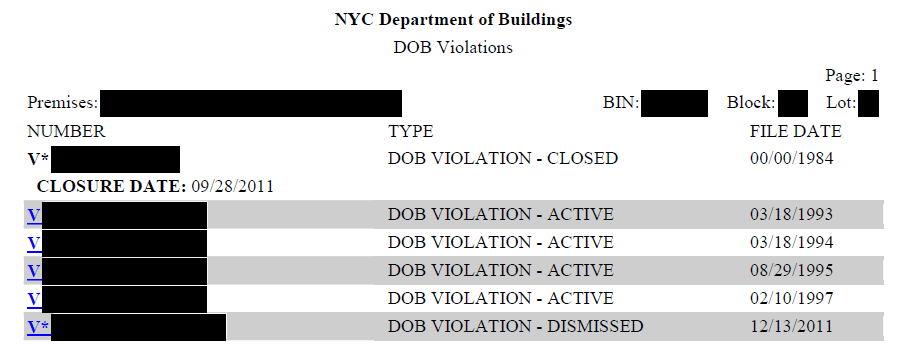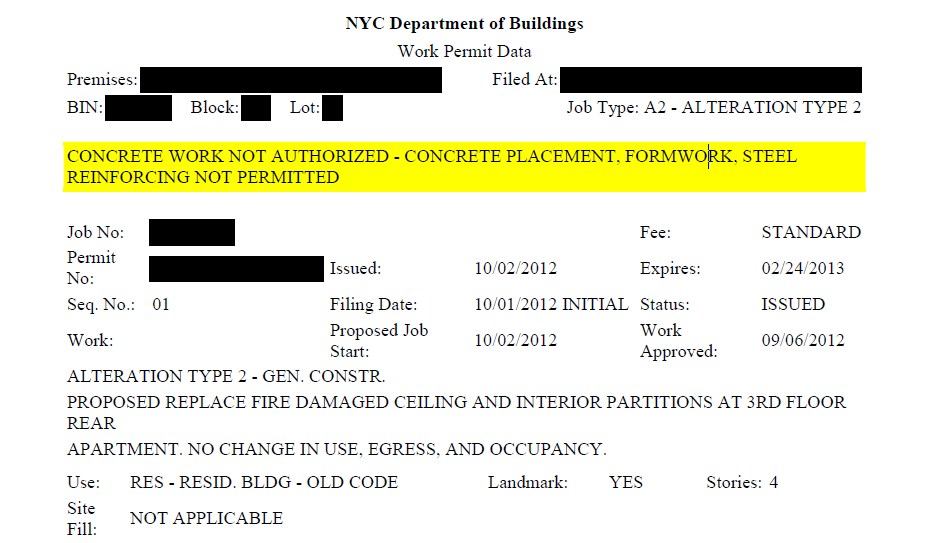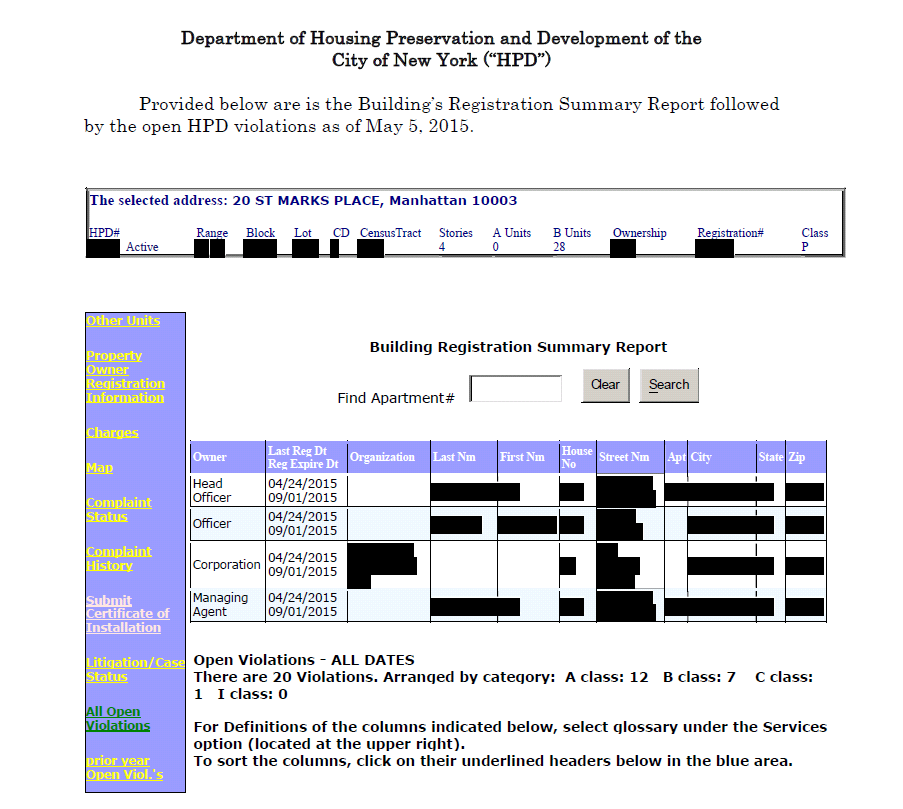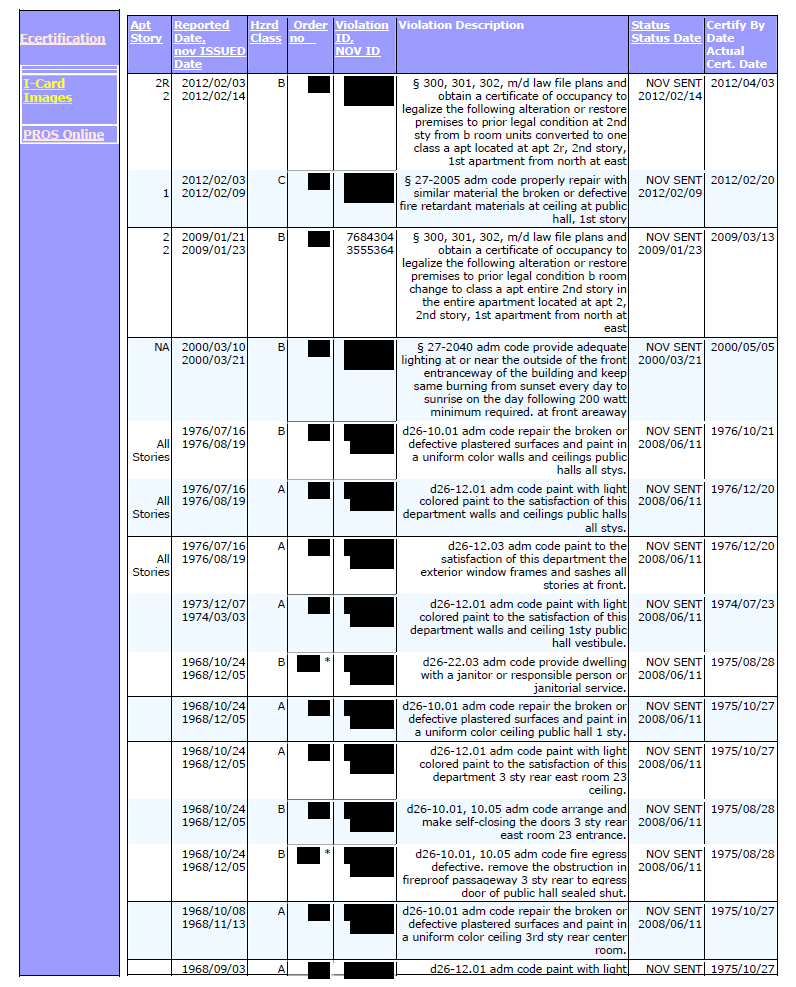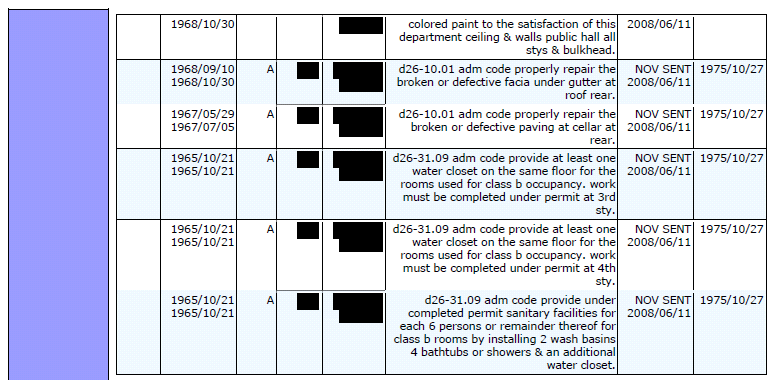Adam Leitman Bailey, P.C. Due Diligence Report 12
DUE DILIGENCE REPORT
Prepared By
Adam Leitman Bailey, P.C.
120 Broadway, Seventeenth Floor
New York, New York 10271
(212) 825 – 0365
alblaw.wpengine.com
May 7th, 2015
EXECUTIVE SUMMARY
This report includes our due diligence research findings and an analysis of the rent regulatory status of all units of [redacted]. Our research approach is customized towards your goal to convert the second floor unit (“the[redacted] unit”) into two four bedroom units and one of the third floor units (“the [redacted] unit”) into a four bedroom apartment. Our understanding is that the commercial first floor and the commercial second floor will maintain their commercial use status. As for the[redacted] residential unit (“the 3rd/4th floor duplex”), we assume that once you obtain legal possession of that unit, you will upgrade and convert it to four bedroom units as well. The single most important element to executing these conversion plans is securing a Certificate of No Harassment (“CONH”) from the Department of Housing Preservation and Development (“DHPD”).
To succeed in the CONH application, you must know why the building is registered in 2015 as a 28-unit SRO, or Class B building, when it is actually a two commercial unit and three residential unit building. The fact that the building is operated and occupied as a common law cooperative1 and promised to be delivered vacant (with the exception of the [redacted] unit) is a great advantage to obtaining a CONH from DHPD. However, DHPD’s interest in preserving affordable housing, including Class B housing too often makes their actions so unpredictable (and politically driven2) that there is no guarantee they will not retaliate against an owner who illegally converted a building’s use.3 The remainder of this Executive Summary sets aside this “building use” issue and assumes that DHPD will take no interest in the illegal conversions made in the building.
The Department of Buildings will not issue work permits or approve plans to perform the third and fourth floor alterations unless DHPD issues a CONH because of the building’s SRO restricted classification. The fact that some of the units will be delivered vacant at closing does not resolve the CONH requirement. However, since the [redacted] unit is occupied by [redacted]who, you indicated, is a shareholder in [redacted] the current owner of the building, and since the [redacted] unit is occupied by the son of [redacted], who is also a shareholder of [redacted], those units are likely to pass DHPD muster relatively easily.
DHPD employs a three year look back period when it investigates an SRO building’s history of tenant harassment. Therefore, if [redacted] and [redacted] son have been living in their apartments for the past three years, then DHPD is not going to find tenant harassment in those apartments.
As more fully explained below, we recommend you obtain an Affidavit of No Harassment from [redacted] son and other people who have lived with him in the apartment in the past three years. A form Affidavit of No Harassment is provided with this report.
Our understanding is [redacted] is the only residential occupant who will not vacate voluntarily. Since [redacted] is also a shareholder of [redacted], if he has been living in the apartment for the past three years, then this unit too should pass DHPD muster relatively easily and your main challenge will be evicting him after closing, that is setting aside the issues that may arise if he does not consent, as a shareholder-owner, to the sale of the property.4 While we cannot guarantee the result, we can state with a medium level of confidence that once HPD understands this building to be a common law cooperative, it will not treat the building as a conventional rental and it will have little interest in the history of bad blood among the shareholders of the building and should therefore not see that bad blood as a reason to deny the CONH.
This report also includes a review and analysis of the history of violations issued by the Department of Housing Preservation and Development of the City of New York (“HPD”) and the New York City Department of Buildings (“DOB”) against the building.
In addition, we searched the files of the Supreme Court of the State of New York, New York County, the Civil Court of the City of New York and the Housing Court of the City of New York for past and pending litigation that may expose you, as a future owner, to liability, and impede your ability to obtain a CONH. As discussed with [redacted] ., we refrained from running a judgment and lien search on the building since [redacted] recently order a title report for the building.
Our investigations produced the following results.
Overcoming the Discrepancy between the “Registered” Use of the Building v. Actual Use of the Building
According to the latest HPD Multiple Dwelling Registration filed by the owner on or about April 24, 2015, the building consists of 28 Class B residential units spread over 4 stories. As you well know, the building actually consists of two commercial units and three residential units.
We reviewed the Department of Buildings Business Information System located online at http://a810-bisweb.nyc.gov/bisweb/bsqpm01.jsp and did not find any jobs or permits issued to convert the building from SRO use to its current use. We did find two illegal conversion complaints, one in 2009 and the other in 2012, alleging SRO “B” Room conversion into a Class A apartment on the second floor. It is unclear whether the complainants were referring to what is now the commercial second floor or the [redacted] unit. Those complaints never evolved into actual DOB violations because the DOB agent was not able to get access to investigate the complaint. Notably, as discussed in further detail below, DHPD issued violations for failure to obtain a Certificate of Occupancy for the 2nd floor conversion.
Illegal conversion complaints alone clearly do not constitute tenant harassment when evaluating an application for a CONH. As previously mentioned, there is no way to know whether DHPD will construe the apparent illegal conversion of the units against you when you apply for the CONH. The Department of Buildings, on the other hand, is highly likely to impose some level of punishment in the form of fines if and when it learns of the illegal conversion. We recommend you consult with an architect and engineer to understand what your liability exposure is and how it impacts your ability to obtain work permits and approvals to carry out your plans.
Screenshots of the complaints from the DOB website are pasted below for your ready reference.
We recommend you require the seller explain and provide detailed documentation, if any, as to when and just exactly how the building came to be a three residential unit building from a 28-unit Class B dwelling. You should conduct a walk through now of the building paying particular attention to the number of units, the freshness of the construction, and the layout of the units.
Single Room Occupancy Law and the CONH Application
The Multiple Dwelling Law defines single room occupancy as “the occupancy by one or two persons of a single room, or of two or more rooms which are joined together, separated from all other rooms within an apartment in a multiple dwelling, so that the occupant or occupants thereof reside separately and independently of other occupant or occupants of the same apartment.”
A “Class B” multiple dwelling is a multiple dwelling which is occupied transiently, i.e. more or less the temporary abode of individuals or families with or without meals.
However, the Class B multiple dwelling is often occupied as an SRO unit when an SRO tenancy is created. Generally speaking, SRO tenancies are created under oral agreements and do not have written leases. The most common way an individual becomes a permanent, SRO tenant is to reside in the building continuously for at least six months as a principal residence, or simply request a lease for a period of six months or longer, which the owner must provide within 15 days or the tenant must reside in the building pursuant to a lease of six months or more, even if actual occupancy is less than six months. Unfortunately for building owners, this type of occupancy routinely gives rise to the creation of permanent tenancies with “special” rent stabilization protections.5
As briefly mentioned in the introduction of this report, in order to effectuate your alteration plans for the building, the seller must provide or you must successfully apply to HPD for a Certificate of No Harassment. As of May 4, 2015, the HPD SRO Unit had no records of such an application ever being filed for this property.
In processing CONH applications, the inquiry period HPD employs is the thirty-six month prior to acceptance of your application by HPD or, in this case, thirty-six months prior to the date that you make your alteration application. The inquiry period ends when HPD makes a final determination. During the inquiry period, HPD investigates any evidence of harassment which if found, would then call for an administrative hearing on whether the owner/prior owner harassed the tenants in order to vacate the building.
As previously mentioned, you should obtain an Affidavit of No Harassment from [redacted] son and any other persons that lived in that apartment for the past three years.6 You should also inquire and ensure that no other persons lived in the [redacted] apartment in the past three years. If she had a roommate or family member living with her, it is best to obtain an Affidavit of No Harassment from those persons as well. You should submit the Affidavits of No Harassment to DHPD with your CONH application.
We also recommend that you obtain an Affidavit from [redacted] and [redacted]s son affirming that they have lived in their respective apartments for X number of years, that [redacted] is a shareholder of the Seller entity and that [redacted]s son is the son of a shareholder of the Seller entity. If [redacted] and/or [redacted]s son has lived in the apartments for less than three years, then you must ascertain who lived in the apartment before them and whether the layout of the apartment was different prior to their occupancy. Ideally, you want Affidavits of No Harassment for every residential occupant of the building in the past three years.
A form Affidavit of No Harassment is provided with this report. The affidavit must be sworn to on a date as close to your closing date or application date as possible and state that the affiant has never been harassed during his or her tenancy which began on the specific date set forth in the affidavit and ended on the specific date set forth in the affidavit.
You may apply for the CONH as a contract vendee if you are in possession of the property and if you can show HPD proof of sufficient property insurance. However, you should keep in mind that any harassing conduct committed by any prior owner will be used against you by HPD when it considers your application which is precisely why it is critical to follow the recommendations set forth through this report.
As previously mentioned, the mere request for a lease for a six month period or more creates a permanent SRO tenancy, which is precisely why our second most critical recommendation is to ensure that the seller does not allow any new occupants into the building whatsoever. Needless to say, you should ensure that the seller is prohibited from entering into any new leases once the contract is signed.
For your convenience and ready reference, together with this report, we provide a copy of the application for a CONH together with submission instructions.
The Division of Housing and Community Renewal of the State of New York (Lack of Rent Registrations)
While SRO building owners are not required to provide renewal leases as he/she is required to do in “standard” rent stabilized apartment buildings7, the owner is required to register the SRO rents with the Division of Housing and Community Renewal of the State of New York (“DHCR”). As of May 5, 2015, the seller had not complied with the registration requirement, thus making it impossible for you to ascertain what transpired in the building prior to its current owner occupancy status. There is a remote chance that a future tenant will question the regulatory status of his/her apartment and in doing so, typically, the first step he/she takes is looking up the DHCR registration for his building. Fortunately, once you obtain a CONH and effectuate your plans with the proper DOB approvals and permits, you can easily show how the building came out of deregulation. Until then, however, the building remains vulnerable to those inquiries.
A copy of the Letter from DHCR indicating there are no cases or registrations for the building is provided with this report.
Landmark Designation
We have confirmed that this building is a designated landmark. Such designations always entail restrictions on what an owner can do with the property, particularly with regard to renovations of the property. The designations of buildings as landmarks vary considerably as to the extent of the prohibited changes to the building. While the most common restrictions have included changes to the façade of the building, this office has come across far more intrusive restrictions, including interior restrictions such as the kinds of permissible plumbing fixtures in the building. It is therefore necessary to thoroughly research just how restricted the designation of this particular building is, something which is outside of the scope of this report, but which this office would be pleased to do on your behalf if you so desire. In any event, you should take note that you should not assume that your plans for the building, setting aside the CONH factors, will be without difficulty encountered at the Landmarks Preservation Commission. We also note in passing that of all the agencies in the United States of America, decisions of the New York City’s Landmarks Preservation Commission enjoy the dubious distinction of nearly never being overturned by a Court. Thus, if there is something that you contemplate that runs afoul of the Landmarks Commission, to all intents and purposes, the Commission’s decision is highly likely to be absolutely final.
New York City Violations Issued Against the Building
NYC Department of Buildings (DOB)
Overview of the Building
The Department of Buildings classifies this building as “S9-Residence Multi U”, which is defined as a “single or multiple dwelling with stores or offices.” This is a Department of Finance classification used to classify the premises’ tax status, as distinct from its legal use which is typically set forth in the Certificate of Occupancy. There is no Certificate of Occupancy for this building on file with the DOB and a walk-thru and inspection of the building is highly recommended and necessary to verify the use of the building and confirm exactly how many and what type of units there are in the building.
A Certificate of Occupancy would indicate the legal use of the property, i.e. commercial, residential, storage, garage use). The lack of a Certificate of Occupancy indicates that the building was constructed prior to 1938, and that there has been no change in use of the property nor have there been any additions to the building.8
The City began in 1938 to require property owners to file a Certificate of Occupancy application if construction or alteration changed their building’s use, occupancy, or means of exit. However, as previously noted, we have reason to believe that the illegal conversion work is recent and therefore a Certificate of Occupancy would be required. This is an area of considerable concern.
In lieu of a Certificate of Occupancy, an owner or prospective buyer may obtain a Letter of No Objection to confirm the legal use of the building. We recommend you request the seller provide a Letter of No Objection. However, if ever you need to know the legal use of this or any building in New York City, you can obtain a Letter of No Objection from the Department of Buildings’ office in the borough where the property is located. Upon request, we can obtain the Letter of No Objection for you. For your convenience, we provide below a link to details regarding obtaining a Letter of No Objection from the Department of Buildings.
DOB Violations
There are 4 open DOB boiler violations. You can view the 4 open violations online using the New York City Department of Buildings’ Buildings Information System (“DOB BIS”) located at http://a810-bisweb.nyc.gov/bisweb/bsqpm01.jsp. You can easily access that site by conducting a Google search on “Building Information System.” We provide a screenshot of the DOB BIS page, as of May 5, 2015, to offer a summary view of the open violations and the dates they were issued. The 4 open violations are all boiler violations issued in the years 1993 through 1997. You should require the seller correct, or if already corrected, certify and pay any imposed fines prior to closing or alternatively, ensure you receive a credit for the cost of correcting violations that are open on the date of closing.
History of Fire at the Building
In October 2012, the Department of Building issued a work permit for alteration work at the “3rd floor rear,” or the [redacted] unit, to replace the ceiling and partitions after a fire that took place at the building. The sublease with [redacted]s son begins in 2013 so it follows that the tenant at the time of the lease was [redacted] himself, unless there is a prior sublease between [redacted] and a former tenant. If the latter, then you should demand a copy of the prior sublease and find out under what terms and conditions that subtenant vacated the apartment because that tenant’s occupancy took place in the past three years and so is subject to DHPD’s thirty-six month inquiry in a CONH application. Ideally, you should obtain an Affidavit of No Harassment from that former tenant, as fully explained above.
A screenshot of the work permit data published on the DOB BIS website, as
of May 5, 2015, is provided below for your reference.
As previously mentioned, there is no guarantee that DHPD will retaliate against a CONH applicant for the illegal conversion work sited in the open 2012 and 2009 violations for failure to obtain a Certificate of Occupancy. Having said that, illegal conversion alone does not constitute tenant harassment.
It may be worth your while to negotiate a credit for each of the open HPD violations or have them resolved by the closing date and demand proof of payment for all associated administrative fees, if any.
Property Shark Report
The Property Shark Report for the building, which includes information pertaining to the neighborhood, ownership, property tax assessment, zoning and size, is provided with this report.
Court Investigations
Housing Court
There is a commercial holdover proceeding currently pending against [redacted] the [redacted] 2nd floor property. That proceeding has held one court appearance on April 22, 2015. The reason for the adjournment could not be discerned from the court file. A copy of the entire file as of May 4, 2015, is provided with this report. It is highly likely that either the case was adjourned for to retain an attorney or adjourned for [redacted] an inquest hearing if [redacted] failed to show up in court. The next court date is May 18, 2015. If you wish, we can informally appear on the case to monitor and report its progress to you. Note that there is no currently holdover proceeding against the residential [redacted] unit.
In 2009, the Seller signed a Consent Order with DHPD presumably agreeing to cure violations issued by DHPD at that time. The only open 2009 violation is the failure to obtain a Certificate of Occupancy (2nd floor). The only way to know if that is the violation subject to the Consent Order is to obtain a copy of the Order either from the Seller or court archives. Currently, cases prior to 2010 are in court archives and can take up to sixteen weeks, from the date we submit a request for the file, to retrieve. We recommend you request a copy of the order from the Seller. If they do not provide it, we can submit a court file request on your behalf.
Civil Court and Supreme Court
There are no Civil Court or Supreme Court cases brought by or against the current and predecessor owners of the building which affect our rent regulatory due diligence analysis.
Judgments and Liens
As you know, customarily prior to closing a title search is run on the property which provides a more complete and up to date picture of the liens held against the property. We urge you to rely on the results of that pre-closing search, particularly since we did not run our standard preliminary investigation on judgments and liens against the property.
CONCLUSION
The area of concern you have already identified to this office is the question as to whether you or anybody else can obtain a Certificate of No Harassment. That is indeed appropriately regarded as an area of concern and there is no reason to rehearse at greater length in this paragraph what has been set forth in the body of the report in detail what the potential problems are with regard to that. However, we must also emphasize that the landmark designation is a source of concern and indeed might explain why the obviously illegal conversion was done illegally. It may well be that the conversion could not be done legally under the rigors of the landmark law. Therefore, the landmark issues require serious investigation as they hold the potential to completely undo your plan for the building. In all other regards, the building appears in good shape from a legal point of view. A mere 20 violations in a 28 unit building is unusually good. Indeed, anything below a 1:1 ratio for Violations/Unit is generally a sign of solid management. However, that generally healthy sign is overcome in this instance by the obviously illegal construction.
